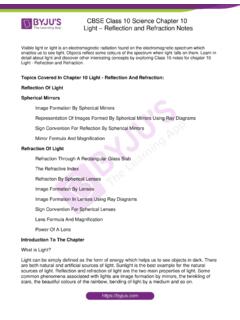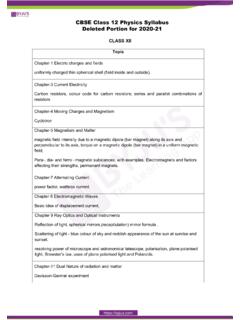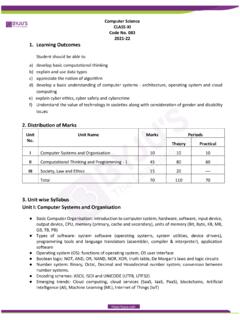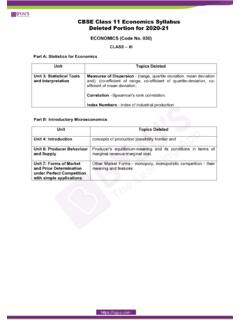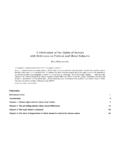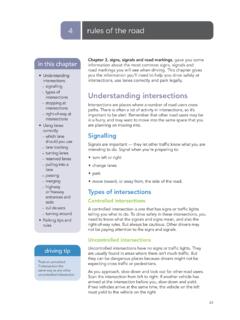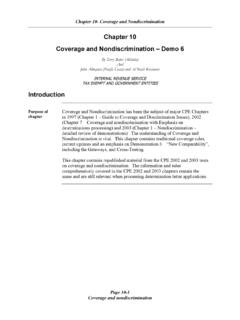Transcription of RS-Aggarwal-Solution-class-10-Maths-Chapter-5-Arithmetic ...
1 RS aggarwal Solutions for class 10 Maths chapter 5 Arithmetic Progression Exercise 5A Page No: 257. Question 1: Show that each of the progressions given below is an AP. Find the first term, common difference and next term of each. (i) 9, 15, 21, 27, .. (ii) 11, 6, 1, -4, . (iii) -1, -5 /6 , -2 /3 , -1 /2 , . (iv) 2, 8, 18, 32, .. (v) 20, 45, 80, 125, . Solution: (i) 9, 15, 21, 27, . Here, 15 9 = 21 15 = 27 21 = 6 (which is constant). Common difference is 6. Or d = 6. Next term = 27 + d = 27 + 6 = 33. (ii) 11, 6, 1, -4, . Here, 6 11 = 1 6 = -5 -4 1 = -5 (which is constant). d (common difference) = -5. Next term = -4 5 = -9. (iii) -1, -5 /6 , -2 /3 , -1 /2.
2 -5/6 - (-1) = 1/6 and -2/3 - (-5/6) = 1/6. d (common difference) = 1/6. Next term = -1/2 + 1/6 = -1/3. RS aggarwal Solutions for class 10 Maths chapter 5 Arithmetic Progression (iv) 2, 8, 18, 32, .. 8 - 2 = 2 2 - 2 = 2. 32 - 18 = 4 2 - 3 2 = 2. d (common difference) = 2. Next term = 32 + 2 = 4 2 + 2 = 5 2 = 50. (v) 20, 45, 80, 125, . 20, 45, 80, 125, . 45 - 20 = 3 5 - 2 5 = 5. 125 - 80 = 5 5 - 4 5 = 5. d (common difference) = 5. Next term = 125 + 5 = 5 5 + 5 = 6 5 or 180. Question 2: Find: (i) the 20th term of the AP 9, 13, 17, 21, . (ii) the 35th term of the AP 20, 17, 14, 11, . (iii) the 18th term of the AP 2, 18 , 50, 98.
3 (iv) the 9th term of the AP 3 /4 , 5 /4 , 7 /4 , 9 /4 , . (v) the 15th term of the AP -40, -15, 10, 35, . Solution: (i)Given: AP is 9, 13, 17, 21, . Here, first term = a = 9. Common difference = d = 13 9 = 4. an = a + (n-1)d RS aggarwal Solutions for class 10 Maths chapter 5 Arithmetic Progression a20= 9 + (20-1)4. = 85. (ii) the 35th term of the AP 20, 17, 14, 11, . Given: AP is 20, 17, 14, 11, . Here, first term = a = 20. Common difference = d = 17 - 20 = -3. n = 35. an = a + (n-1)d a35 = 20 + (35-1)(-3) =. -82. (iii) the 18th term of the AP 2, 18 , 50, 98, . Given: AP is 2, 18 , 50, 98, . or 2, 3 2 , 5 2, 7 2,.. Here, first term = a = 2.
4 Common difference = d = 3 2 - 2 = 2 2. n = 18. an = a + (n-1)d a18 = 2 + 34 2 =. 35 2. RS aggarwal Solutions for class 10 Maths chapter 5 Arithmetic Progression (iv) the 9th term of the AP 3 /4 , 5 /4 , 7 /4 , 9 /4 , . Given: AP is 3 /4 , 5 /4 , 7 /4 , 9 /4 , . Here, first term = a = 3/4. Common difference = d = 5/4 - 3/4 = 1/2. n=9. an = a + (n-1)d a9 = 3/4 + (9 -1)1/2. = 19/4. (v) the 15th term of the AP -40, -15, 10, 35, . Given: AP is -40, -15, 10, 35, . Here, first term = a = -40. Common difference = d = -15 - (-40) = -15 + 40 = 25. n = 15. a_n = a + (n-1)d a15 = -40 + (15 - 1)25 =. 310. Question 3: (i)Find the 37th term of the AP 6, 7 3 /4 , 9_1 /2 , 11_1 /4.
5 (ii)Find the 25th term of the AP 5, 4 1 /2 , 4, 3_1 /2 , 3, . RS aggarwal Solutions for class 10 Maths chapter 5 Arithmetic Progression Solution: (i)Given AP is Here, first term = a = 6. Common difference: Here, first term = a = 6. Common difference = d = -15 - (-40) = -15 + 40 = 25. n = 37. an = a + (n-1)d a37 = 6 + (37-1)(7/4). = 69. (ii) Given AP is 5, 4_1 /2 , 4, 3_1 /2 , 3, . Given AP is Here, first term = a = 5. Common difference: n = 25. RS aggarwal Solutions for class 10 Maths chapter 5 Arithmetic Progression an = a + (n-1)d a25 = 5 + (25-1)(-1/2). = -7. Question 4: Find the value of p for which the numbers 2p 1, 3p + 1, 11 are in AP.
6 Hence, find the numbers. Solution: If 2p 1, 3p + 1, 11 are terms in AP, then a2 a1 = a3 a2 ..(1). From given: a1 = 2p 1. a2 = 3p + 1. a3 = 11. From (1), we get (3p + 1) (2p 1) = 11 (3p + 1). 3p + 1 2p + 1 = 11 3p 1. p + 2 = 10 3p 4p = 8. p=2. For p = 2, these terms are in AP. Question 5: Find the nth term of each of the following APs: (i) 5, 11, 17, 23, . (ii) 16, 9, 2, -5, . Solution: RS aggarwal Solutions for class 10 Maths chapter 5 Arithmetic Progression (i)AP is 5, 11, 17, 23, . Here, first term = a = 5. Common difference = d = 11 5 = 6. Now, an = a (n 1)d = 5 + (n 1) 6. = 5 + 6n 6. = (6n 1). (ii) AP is 16, 9, 2, -5.
7 Here, first term = a = 16. Common difference = d = 9 16 = -7. an = a + (n 1)d = 16 + (n 1) (-7). = 16 7n + 7. = (23 7n). Question 6: If the nth term of a progression is (4n 10) show that it is an AP. Find its (i) first term, (ii) common difference, and (iii) 16th term. Solution: nth term of AP is 4n 10 (Given). RS aggarwal Solutions for class 10 Maths chapter 5 Arithmetic Progression Putting n = 1, 2, 3, 4, , we get At n = 1: 4n 10 = 4 x 1 10 = 4 10 = -6. At n = 2: 4n 10 = 4 x 2 10 = 8 10 = -2. At n = 3: 4n 10 = 4 x 3 10 = 12 10 = 2. At n = 1: 4n 10 = 4 x 4 10 = 16 10 = 6. We see that -6, -2, 2, 6, are in AP. (i)first term = -6.
8 (ii) Common difference = -2 (-6) = 4. (iii) 16th term: Using formula: an = a + (n 1)d Here n = 16. a16 = -6 + (16 1)4 = 54. Question 7: How many terms are there in the AP 6, 10, 14, 18, . 174? Solution: Given: AP is 6, 10, 14, 18, , 174. Here, first term = a = 6. Common difference = d= 10 6 = 4. To find: the number of terms (n). Last term = a + (n 1)d 174 = 6 + (n 1) 4. 174 6 = (n 1) 4. n 1 = 168 /4 = 42. n = 42 + 1 = 43. RS aggarwal Solutions for class 10 Maths chapter 5 Arithmetic Progression There are 43 terms. Question 8: How many terms are there in the AP 41, 38, 35, , 8? Solution: Given: AP is 41, 38, 35, , 8. Here, first term = a = 41.
9 Last term = 8. Common difference = d = 38 41 = -3. To find: the number of terms (n). Last term = a + (n 1)d 8 = 41 + (n 1)(-3). 8 41 = (n 1)(-3). n 1 = 11. n = 11 + 1 = 12. There are 12 terms. Question 9: How many terms are there in the AP is 18, 15 1/2 , 13, , -47 ? Solution: Given: AP is 18, 31/2 , 13, , -47. Here, first term = a = 18. Last term = -47. Common difference = d = -5/2. To find: the number of terms (n). Last term = a + (n 1)d RS aggarwal Solutions for class 10 Maths chapter 5 Arithmetic Progression -47 = 18 + (n . 1)(-5/2). -47 - 18 = (n - 1)(-5/2). n = 27. There are 27 terms. Question 10: Which term of the AP 3, 8, 13, 18, is 88?
10 Solution: Let nth term is 88. AP is 3, 8, 13, 18, . Here, First term = a = 3. Common difference = d = 8 3 = 5. nth term of AP is an = a + (n 1) d Now, 88 = 3 + (n 1)(5). 88 3 = (n 1) x 5. n 1 = 88 /5. or n = 17 + 1 = 18. Therefore: 88 is the 18th term. Question 11: Which term of the AP 72, 68, 64, 60, .. is 0? Solution: AP is 72, 68, 64, 60, .. Let nth term is 0. RS aggarwal Solutions for class 10 Maths chapter 5 Arithmetic Progression Here, First term = a = 72. Common difference = d = 68 72 = -4. an = a + (n 1)d 0 = 72 + (n 1)(-4). -72 = -4(n 1). n 1 = 18. n = 18 + 1 = 19. Therefore: 0 is the 19th term. Question 12: Which term of the AP 5 /6 , 1, 1 1 /6 , 1 1 /3.

